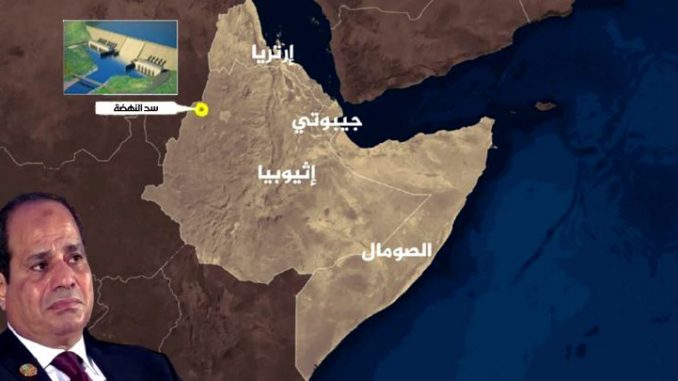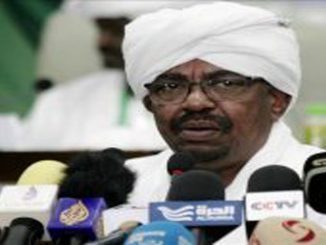
The Horn of Africa region, home to the countries of Djibouti, Eritrea, Ethiopia, and Somalia, has been of particular importance to the Egyptian leadership throughout the ages since the time of the Pharaohs, through Mohamed Ali Pasha, who wanted to expand the borders of Egypt to the Nile sources, up to the Nasserite era
This concern is due to the direct geographical link between Egypt and some countries adjacent to the Horn of Africa, such as Sudan, or because of the existence of the River Nile in Egypt and the fact that it flows from countries like Ethiopia, Kenya, and Uganda; as well as the existence of the Red Sea which has served as a communication medium between Egypt and Africa. The Red Sea has also played a significant role in periods of peace and war for the Egyptian national security since the tripartite aggression of 1956, through a setback of 1967, up to the 1973 war, where Bab al-Mandeb Strait was closed.
Hence, Egypt’s national security is greatly influenced by the various developments witnessed by these countries, whether they were internal developments “within the countries of the Horn of Africa” or even the inter-developments, where Egypt has taken certain positions with respect to these developments in the light of its various strategic interests.
In the light of the recent settlements in the Horn of Africa, which started with the settlement of the dispute between Ethiopia and Eritrea over the Badme Triangle, through the reconciliation between Somalia and Eritrea, up to the reconciliation between Djibouti and Eritrea, two questions arise:
First, what is Egypt’s role in these settlements?
Second, how could Egypt benefit from these settlements, especially with regard to the issue of the Grand Ethiopian Renaissance Dam (GERD), as the most important issue in the current period?
Egypt’s role in the Horn of Africa
In the light of analysis, and not in the context of information that may be confidential in the process of negotiating these settlements, it can be said that Egypt had nothing to do with the historic settlement between Ethiopia and Eritrea, which opened the door to subsequent settlements in the region, probably for two reasons: First, as that it means, in short, Egypt’s loss of one of the most important pressure cards on Ethiopia, i.e. Eritrea. (According to the Ethiopian narrative, Egypt used to provide support to the Oromo Front. Second, because Eritrea has not made any concessions in this settlement. Rather, it has obtained free Ethiopian recognition of its right in the border region of Badme. It is also unreasonable to say that Cairo practiced pressures on Addis Ababa to fulfill this settlement, because it has not succeeded so far in pressuring it to accept its demands regarding the GERD. Perhaps it is pessimistic to say that this agreement will have negative effects on the Egyptian negotiating position with regard to the GERD, for the simple reason that the bilateral agreement between Asmara and Addis Ababa stipulated, inter alia, that the opposition in both countries must not be supported. However, Ethiopian Prime Minister Abiy Ahmed went far beyond this by removing the Oromo Front from the lists of terrorism and allowing the return of its leaders to the country, which means their involvement in the political process and abandoning any external support.
Egypt and making use of the Horn of Africa
Despite of this seemingly pessimistic view, there is a glimmer of hope, which is the current stumbling of the construction of the Grand Ethiopian Renaissance Dam, which may take ten years, according to Abiy Ahmed, to see the light. This means that there could be a benefit for Egypt in terms of the period of filling of the reservoir, but how??
Before attempting to answer this question, it is important to point out that Abiy Ahmed’s statements do not mean that the construction of the GERD has stopped, but that the process of filling, operation and generation (of electricity) is delayed: for construction reasons, which is the most dangerous, or for operational reasons, which is the least dangerous. This means that once these problems are overcome, the process of filling and operation that has been long awaited by the Ethiopians who are its primary source of funding will have to be accelerated, which may make Abiy reject the Egyptian proposal to extend the filling process to 10 to 15 years instead of 3, 5 up to 7 years, according to the initial Ethiopian proposal. However, Egypt can still use an important card in cooperation and coordination with Sudan, i.e by announcing that the construction of the dam could pose a real threat to both countries, as it is liable to collapse in the event of presence of serious defects in the construction process, which will have disastrous effects on Sudan first and then on Egypt.
Recently, there have been growing doubts about the construction process after a report issued by some engineers of the Italian company Salini which is responsible for the GERD construction in November 2016, titled: “What if cracks appeared in the dam? which prompted Sudan to ask the Ethiopian side to host a delegation of Sudanese experts to check on the construction process; and the delegation actually demanded introduction of some amendments, which Ethiopia has responded to positively, reducing the height from 175 meters to 155 meters. Therefore, Cairo and Khartoum can call, through some specialists in dam engineering as Egyptian Expert, Mohamed Hafez, “for forming a neutral global technical committee to discuss the structural aspects.”
It is noteworthy that this proposal, which I agree with, has been demanded by Egypt specifically after the issuance of the report of the Committee of Experts, in June 2013, but it was ruled out by Ethiopia, which insisted that only the consulting offices should discuss the effects of the dam on Egypt and Sudan, taking into consideration that the decisions made by these offices are non-binding.
In fact, re-introduction of such proposal by Egypt and Sudan, despite the likely rejection by Ethiopia, may represent a pressure tool on Abiy Ahmed, especially that there are similar precedents in Ethiopia. In this case, Abiy Ahmed may be prompted to agree to this, or to seek settlement of these problems either by reducing the size of the dam, which means reducing the likely damage that it could cause, or to reach compromises for the period of filling and operation … and then Egypt and Sudan may propose to participate in bearing the burden of the process of the construction readjustment.
But before that, it is necessary to achieve unity between the leaders of the Nile Valley through the activation of the four freedoms agreement signed in 2004, which means freedom of movement, residence, work and ownership, as well as the preference of the cooperative aspects to the controversial aspects, especially regarding the triangle of Halayib and Shalatin, which could be a means of integration rather than an issue of dispute. The experience of settling the Ethiopian-Eritrean conflict may well be remembered. Despite the war between the two sides in 1998 and 2000, and its horrific effects, the dispute has been resolved by a courageous political decision, which means that disputes or even conflicts can be resolved if the political will of the parties exists.
By: Dr. Badr Hassan Shafei, an Egyptian academic, who obtained his PhD in Political Sciences from Cairo University in 2011. He is specialized in African Studies, and ‘Conflict Resolution in Africa’ and ‘Role of Private Security Companies in African Conflicts’ are among the books he has written.
(The article was published in the Egyptian Institute for Studies on 14 Oct. 2018))



